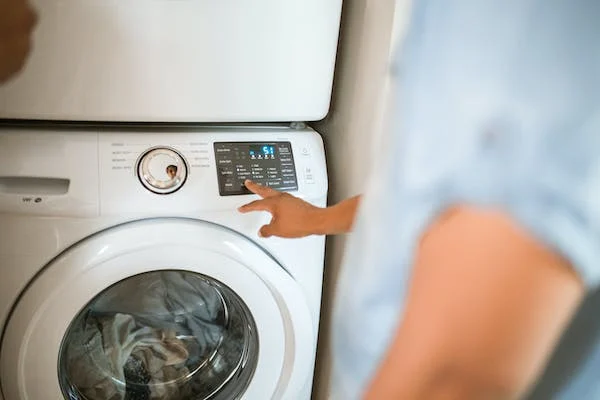How much does it cost to run a washing machine?
Our clothes affect our confidence, wellbeing, and how we present ourselves.
We choose outfits that met our needs, budgets, and sense of style. Looking after those clothes is of equal importance, so our appliances also need to meet our needs, budget, and home style.
With rising cost of living and the UK reputed to have the second highest rate of household electricity prices globally, it’s hardly surprising we’re looking to save money when we can.
We need to consider not only the initial cost of our appliances but also to understand what impact our choice has on our electricity bills.
Have you ever considered how much does it cost to run a washing machine?
How to read washing machine energy ratings?
If you’re wondering how much does it cost to run a washing machine, you first need to understand how that cost is measured.
Energy-efficiency labels have been used on white goods in the UK for at least 25 years. These labels help consumers understand how much energy a product uses.
This allows people to compare different products to make sure they’re buying something they can count on to meet their needs, at a price point that suits their budget, and with an energy-efficiency rating that keeps their environmental footprint low.
In the UK, there has been a recent upgrade of the energy-efficiency labelling system.
In the past, many products would have an A or higher (A+++) energy-efficiency rating.
As technological advances occurred, it became possible for manufacturers to produce more energy-efficient (and cost-efficient) products.
According to the Energy Saving Trust ‘the new scale is set to allow room for future innovation and in most cases the best/most efficient product will receive a B or C rating, and an average product will be rated at a D or below’.
As explained by energylabel.org.uk, to read washing machine energy ratings we need to look at:
1. The colour code with letter indicating A (in green) is the highest efficiency, through to G (in red), which is the lowest. The higher the rating, the better the efficiency.
2. There is a weighted energy consumption based on how many kilowatts per hour (kW/h) the washing machine uses per 100 loads of washing. Because you pay your energy bill based on how many kilowatts of energy you use, this part helps you compare how much does it cost to run a washing machine across different models based on their energy consumption.
3. There is information to help you understand the length of time of the eco programs and 40 to 60° cycles, which impact on energy efficiency across different models.
4. The water consumption of the machine measured in litres per year. Remember, water usage also affects the cost of running a washing machine. The more water efficient your washing machine, the less you will pay in your water bill.
5. The efficiency of the spin cycle. It’s important to balance the care of your clothes with efficiency of water removal (particularly if using a tumble dryer as part of your laundry routine). If the washing machine has high efficiency in the spin cycle, that helps lower the running costs of the machine.
6. Noise emissions are also included on the new labelling system. This indicates how much noise the spin cycle emits, which can be important in apartment living or if you have young children sleeping.
In addition to these key factors, you’ll find a QR Code for more product information, the name of the supplier and the model identifier. These are all ways you can research different products to better compare and understand the cost of running a washing machine.
What factors affect the cost of running a washing machine?
As we’ve seen, there are several factors affecting the cost of running a washing machine.
Additional ones include the temperature of the wash, the capacity of the machine, and even the style of the machine, with front loaders and top-loading machines offering various advantages and disadvantages.
How much does it cost to run a washing machine?
After initial purchase, delivery, and installation costs, let’s look at exactly how much it costs to run a washing machine.
Energy Sage does a great break down of the energy costs of running a washing machine. For
example:
- If you run a 900 W washing machine once a week, that's 0.9 kilowatt-hours (kWh) of electricity per week, 3.9 kWh per month, and 46.8 kWh per year.
- Running that same washer three times a week comes to 2.7 kWh per week, 11.7 kWh per month, and 140.4 kWh per year.
- If you run a 900 W washing machine every day, that's 6.3 kWh of electricity per week, 27.3 kWh per month, and 327.6 kWh per year.
To work out energy cost you then multiply the amount of kW/h by the cost of electricity per kilowatt-hour in the UK.
How to save money when running your washing machine?
There are ways you can save money when running your washing machine.
Some of them are after purchase, such as how often you wash, using a full load rather than a partial load, choosing the right cycle for your load, and using cold water with an enzyme-based washing powder rather than the added expense of warm or hot water.
These are great strategies, but true savings when considering how much does it cost to run a washing machine comes down to choosing the right washing machine.
As highlighted by experts in Choice, ‘Buying the wrong washing machine could cost you more… you could also end up paying more in energy and water bills and may even find yourself having to replace your clothes more regularly’.
A washing machine is an investment, and you will want to ensure that you have the guidance of experienced suppliers coupled with competitive pricing and outstanding customer service.
At Home Feeling, we’re dedicated to taking the stress out of searching by helping you choose the right washing machine from carefully selected, high-quality products.
As an added bonus you can have it safely delivered by trusted couriers free of charge to wherever you are located nationwide.
Contact Home Feeling today to find the right products for your home.

